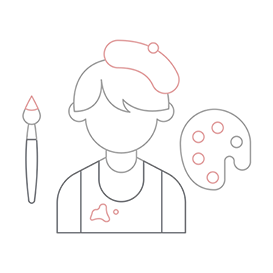Peace Through Art; "Made in Palestine" humanizes the Middle East conflict
When the Art Car Museum presented the thought-provoking exhibition "Secret Wars" shortly after September 11, 2001, it had the FBI dropping by to
Houston Press
Jul 31, 2003

Inside the tent, the stray threads of the embroidered names dangle down like the lost threads of countless lives in communities with unfamiliar names like Al-Hamra, Kafra, Yasur. Imagine for a moment leaving everything you have behind to live in such a makeshift, primitive shelter. The moving piece is especially topical considering that since the late 1980s there has been a movement among some Israeli historians to revise the popular view of the 1948 Arab-Israeli war and subsequent exodus of between 600,000 and 700,000 Palestinians. Most Israelis grew up being taught that the Palestinians had left of their own accord. But this was the exception far more than the rule, and Israeli scholars are refuting this account of events to deal with the vast numbers who were driven out or barred from their homes. The tent is, suitably, a refugee memorial, not of granite and bronze but of cheap, portable canvas and aluminum poles.
Negative Incursion (2002) presents the bleak vision of Rula Halawani, who lives in Jerusalem and teaches photography in the occupied West Bank city of Ramallah, where she was present on March 28, 2002, when the Israeli incursion occurred. Drawing on her press credentials, she took photographs of the devastation. The photos are printed large-scale and in the negative, heightening the scenes` sense of the inhuman and otherworldly. The disorienting images do not allow us to dismiss them as just some newspaper photo from somewhere. A family huddles next to the rubble of a demolished building under a rigged-up tarp. A woman stands in white in the foreground of an image while a field of destruction fills the background. An ambulance rests in a street with its door blown off. A crumpled body lies dead on the sidewalk next to a tank, a small bright pool of blood next to its ankle.
Working with existing media images, Rana Bishara transforms them into frail and ephemeral pictures by printing them on panes of glass that she suspends from the ceiling. For her printing medium she chose not ink but chocolate, which has the dusty look of dried blood. The fragile panes of glass hang densely in the room, and visitors must carefully navigate the suspended panels and their images of grief and violence: two soldiers posing for a picture over the body of a dead man, women crying, a man holding a child, the faces of the dead. Rock throwing is an icon of conflict in the occupied territories. Nida Sinnokrot created a series of tiny sculptures using rocks half-dipped in rubber. These are smooth, tactile and visually appealing objects with sinister undertones. Lined up along the baseboards of the galleries, they appear as a weapons stockpile or like tiny stand-ins for individuals. The rubber alludes to the rubber bullets shot by Israeli soldiers against Palestinian civilians. In a sad twist on the story of David and Goliath, the stones refer to the rocks and chunks of rubble thrown by Palestinian children against Israeli tanks. Rajie Cook`s Ammo Box (2003) takes a similar tack with a pointed commentary on U.S.-sponsored militarization: a giant replica of a United States military ammunition box filled with stones.
Also by Sinnokrot, Al Jaz/CNN (2002) presents satellite streams from Al-Jazeera and CNN side by side. Each channel presents male and female anchors in suits with an up-to-the-minute scroll of text moving across the bottom of the screen -- except the Arabic of Al-Jazeera flows for right-to-left reading. In viewing the piece, non-Arabic speakers rely on visual juxtapositions, although comparing the dialogue would be especially intriguing. The piece changes with each network`s programming and responses of news events. We compare spin to spin. Other works present personal, individual experiences. The works of Zuhdi Al-Adawi and Muhammad Rakouie were created during their imprisonment by the Israelis. Both men now live in refugee camps in Syria. The finely detailed images created in crayon on cut pillowcase linens have the visual aura of "outsider art." They present images that range from the poignant -- an inmate on a hunger strike -- to the surreal, to the nationalistic. The images using the colors of the Palestinian flag and depicting struggle for independence were prohibited by authorities and had to be smuggled out of the prison.
Emily Jacir`s work appears again but this time as a video documenting her daily crossing of the militarized Surda checkpoint as she commutes from home to work. Jacir had originally walked the checkpoint holding the camera but was detained by Israeli soldiers for three hours and had her tape confiscated. She then shot images by hiding a camera in her purse. The low-angle video of bare ground, empty buildings, rubble and passersby conveys the sense of furtiveness and danger in a daily routine. The found object used in Tyseer Barakat`s work Father (1997) embodies a sad irony. It is a musty-smelling wood file cabinet with flat drawers, a cast-off of the Israeli army. Prior to 1948 it contained the files of Jewish refugees fleeing the holocaust and its aftermath -- refugees being resettled in cities like Haifa, Majdal, Jaffa and Safad. Images burned into the bottom panels of the drawers record the story of the artist`s father "from his happy childhood days in Majdal to his forceful deportation to Jabalya refugee camp to his toil in his old age to support us to his sickness and death." The original labels for the file drawers ("Jews coming to Majdal," etc.) were torn off by Israeli tax officials who confiscated the box for three months, preventing its inclusion in an art biennial.
A secular, liberal, Jordanian friend of mine has a cartoon taped to his kitchen cabinet. It shows two soldiers knocking on Mrs. Mitchell`s door as a guilty Dennis the Menace stands next to them. The text reads, "I`m sorry, ma`am, but your son was caught throwing stones. We are going to have to bulldoze your home." You see the blade of the dozer sharing the picture plane with the tidy home and white picket fence. My friend, who was educated in the United States, appreciates the way that little drawing uses characters from American pop culture to deftly make its point. As Americans we are stereotyped as uninformed about world history and politics, but that stereotype is truest when it comes to the Middle East. Imagine the U.S. Marine stationed at the American embassy in Amman who earnestly asked my friend to help explain Middle East politics to him. His first question: "So tell me, is Yasir Arafat Jewish?"
Misunderstanding about the Palestinian-Israeli conflict is not helped by the fact that extremists on both sides control most of the dialogue. But as "Made in Palestine" demonstrates, art can sometimes make a point or convey an experience far more effectively than politicians or the media. While some of the works wander into the territory of craftsy polemics, this is by and large a strong show. The Palestinian-Israeli situation is a far more complex and multidimensional thing than any display of art could ever hope to deal with, and coming to a clear conclusion is by no means the goal of this exhibition. The suffering of the Jews prior to the creation of the state of Israel and the Israelis` subsequent experiences of terrorism have engendered their own artistic expression. But this show presents artistic voices not often heard. When you view objects and images created by someone, they become humanized. The road to peace begins with understanding the suffering and the point of view of the other. Art can help.
COPYRIGHT: Copyright NT Media, LLC Jul 31, 2003. Provided by Proquest- CSA, LLC. All Rights Reserved. Only fair use as provided by the United States copyright law is permitted.
PROQUEST-CSA, LLC- MAKES NO WARRANTY REGARDING THE ACCURACY, COMPLETENESS, OR TIMELINESS OF THE LICENSED MATERIALS OR ANY WARRANTY, EXPRESS OR IMPLIED.










